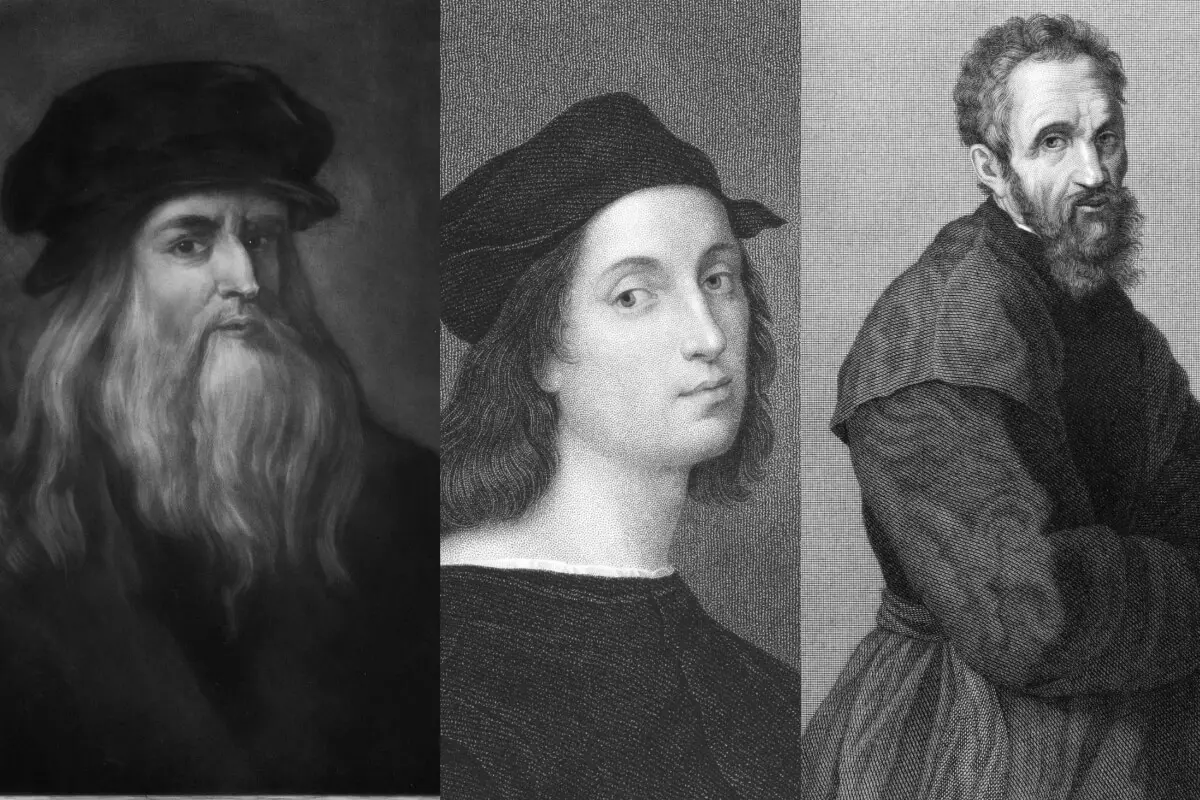When we talk about the peak of art, where creativity, beauty, and sophistication come together in a grand symphony, the High Renaissance period steals the spotlight. This era, flourishing in the late 15th and early 16th centuries, wasn’t just another chapter in art history but a monumental shift that redefined what art could be. Distinguished by its focus on balance, detail, and the human form, High Renaissance art brings to the stage an unparalleled mastery that continues to captivate our imagination.
It’s a period marked by genius minds like Leonardo da Vinci and Michelangelo, who didn’t just create art; they breathed life into marble and canvas, influencing countless generations. As we dive into the heart of the High Renaissance, prepare to be amazed by the stories, techniques, and sheer brilliance that hallmark this golden age of art.
Table of Contents
- Defining High Renaissance Art
- Key Figures of the High Renaissance
- Iconic Works of High Renaissance Art
- Influence and Legacy
- Related Questions
Defining High Renaissance Art
What Sets High Renaissance Art Apart?
Alright, art lovers and curious minds, buckle up because we’re diving into the world of High Renaissance art! This period in art history is like the golden age of creativity, innovation, and pure genius. So, what makes High Renaissance art stand out from the crowd? Let’s find out.
First, the High Renaissance era took place roughly between 1490 and 1527. This time frame is packed with groundbreaking art that changed the game forever. Three superstar artists always steal the spotlight when discussing the High Renaissance: Leonardo da Vinci, Michelangelo, and Raphael. These guys were the Beyoncés of their time—total game-changers in the art world.
You might wonder, “What exactly sets High Renaissance art apart?” Friends, it’s all about harmony, balance, and a dash of scientific exploration. Artists during this period were obsessed with creating the perfect composition. They used techniques like linear perspective to make their paintings pop with a three-dimensional feel. It was like they were pulling scenes right out of real life and onto the canvas.
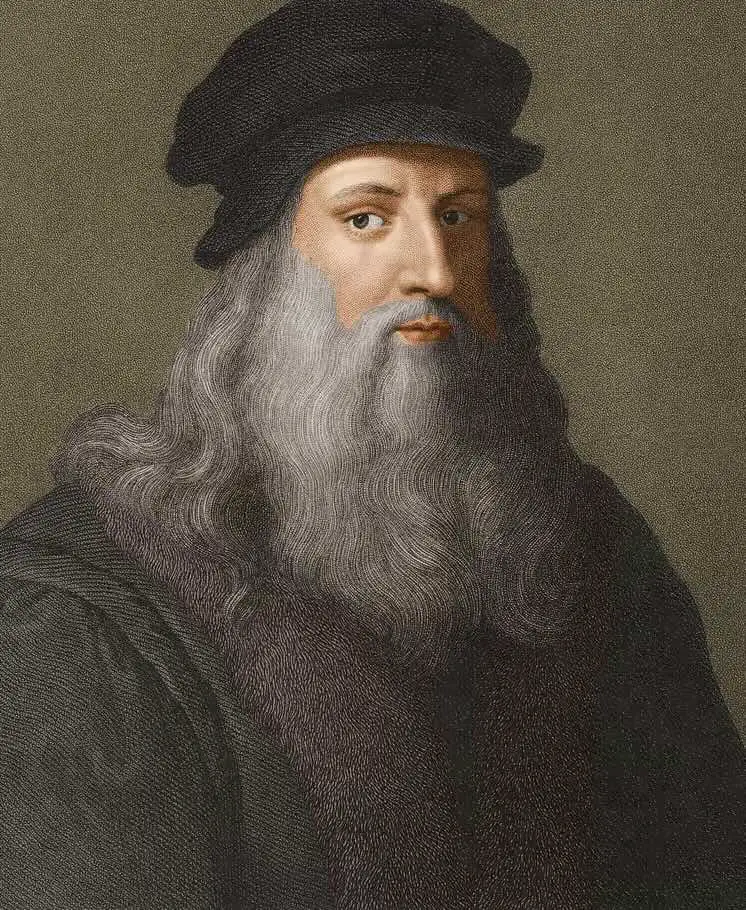
Leonardo da Vinci was the king of using science to elevate his art. Ever heard of the Vitruvian Man? Leonardo shows off how art and anatomy can create something mind-blowingly beautiful. His attention to detail and fascination with the human body brought realism to art that was pretty much unheard of.
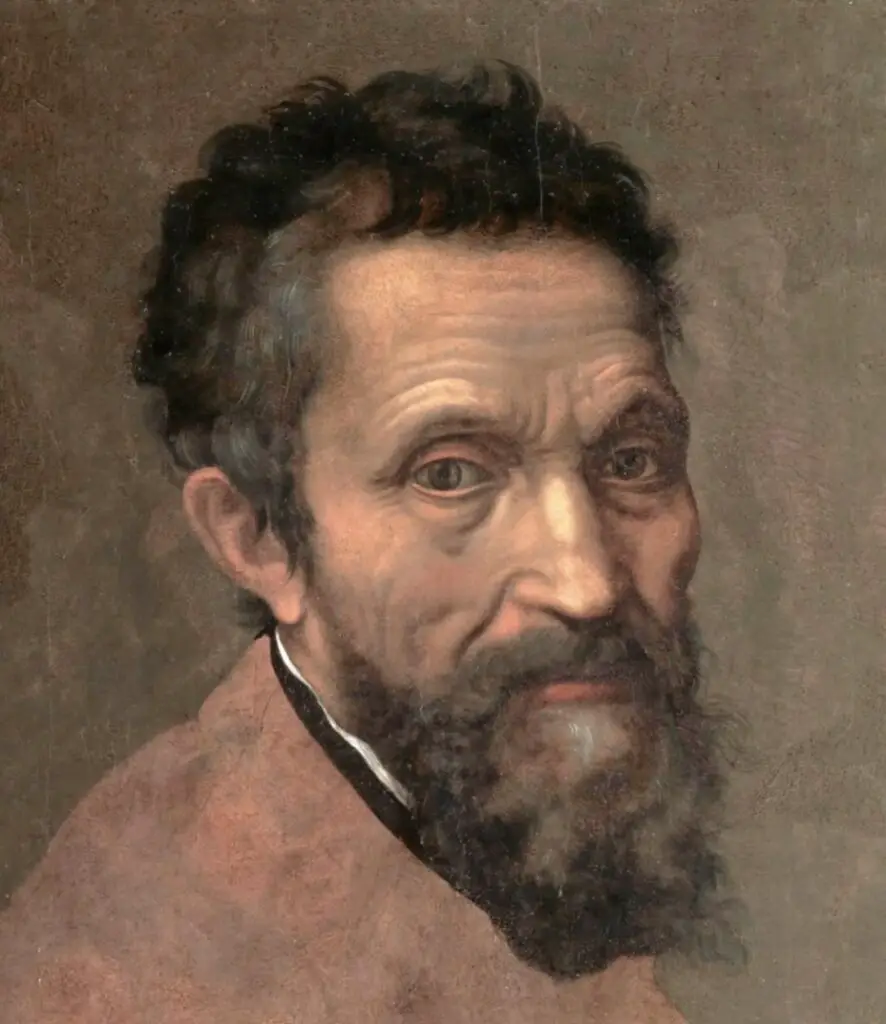
Then, we’ve got Michelangelo, who, with his sculpting skills, could make marble seem like soft flesh. His Statue of David? It’s not just a dude standing there; it’s a masterpiece of motion and emotion captured in stone. With those vibrant frescoes, Michelangelo’s work in the Sistine Chapel took painting to a new celestial level.
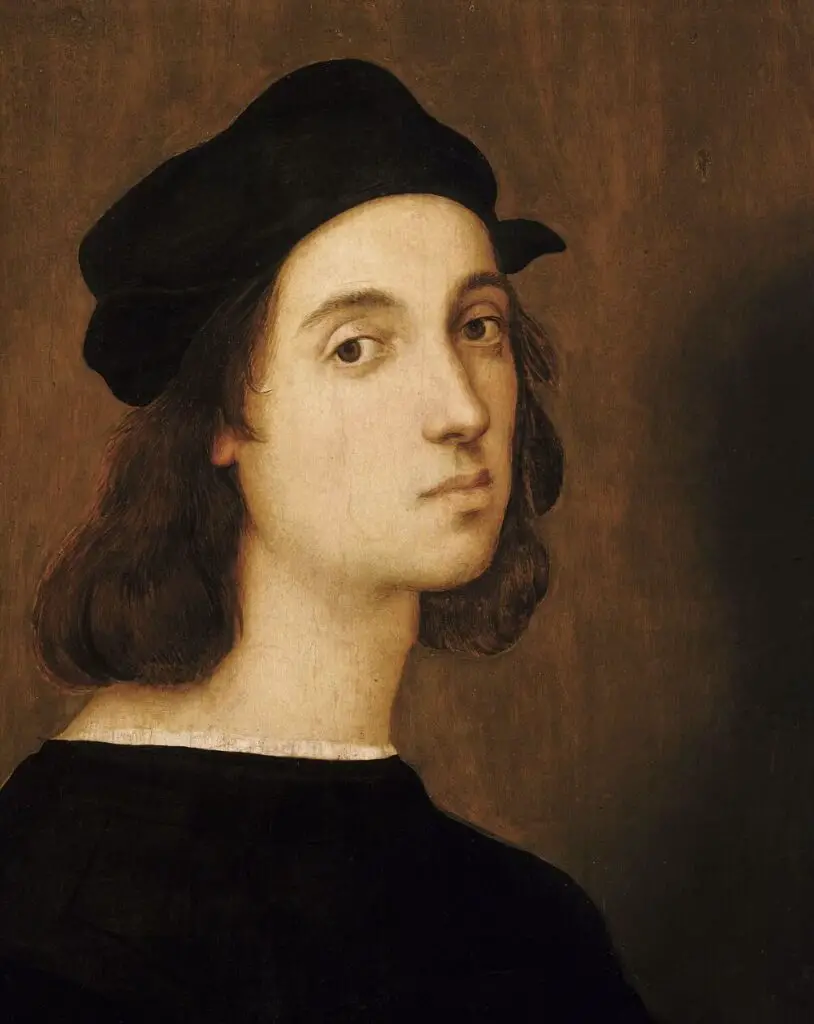
Lastly, Raphael brought grace and beauty to the High Renaissance. His School of Athens is like a who’s who of ancient philosophers, all hanging out together. Raphael had this knack for creating compositions that felt both grand and intimate. His use of color and light made his paintings glow from within.
High Renaissance art wasn’t just about creating pretty pictures; it was a blend of art and science, emotion and intellect, reality and idealism. Artists were pushing boundaries, experimenting with new techniques, and aiming for perfection that spoke to the soul. They focused on humanism, exploring themes of beauty, nature, and the human experience in a relatable yet ethereal way.
In the end, what sets High Renaissance art apart is its enduring legacy. These artists and their works continue to inspire and astonish us centuries later. They captured the spirit of their time while creating timeless pieces that still resonate with us today. That, my friends, is the true magic of High Renaissance art – a bridge between the past and the present, showing us the beauty of the human spirit through the ages.
Key Figures of the High Renaissance
Delving deeper into the world of High Renaissance art, there’s so much more to explore beyond the surface—beyond the stunning visuals and familiar names. This period, rich in innovation and creativity, saw artists pushing the boundaries in ways that would shape the course of art history.
One of the lesser-discussed yet equally fascinating aspects of this era is the profound influence of patronage. Influential figures like Lorenzo de Medici in Florence and Pope Julius II in Rome were instrumental in creating some of the most iconic works. Their support was not just financial but often profoundly personal, involving close relationships with the artists. This connection allowed for ambitious projects that were as daring in concept as they were in execution.
The High Renaissance was also a time of intense rivalry among artists, driving them to reach new heights of achievement. The competition between Michelangelo and Leonardo da Vinci is legendary. Although primarily known for their masterpieces, their rivalry spurred each to innovate and excel, leaving an indelible mark on the art world. Stories of their encounters highlight the intense drive for excellence and recognition that characterized the period.
Additionally, the artistic techniques developed during this time were groundbreaking. Beyond linear perspective, artists experimented with chiaroscuro (strong contrasts between light and dark) and sfumato (a technique of blending colors in such a way that there is no noticeable transition). These techniques allowed for a more nuanced, emotive, and immersive art experience, adding layers of meaning and realism.
Exploration of mythology and antiquity was another hallmark of High Renaissance art, reflecting the era’s fascination with the classical past. Artists like Botticelli, whose work is often associated with the Early Renaissance, paved the way with their mythological subjects, influencing High Renaissance artists to explore these themes with their newly developed techniques and perspectives. This blending of the ancient and modern added depth to the art, making it visually striking and intellectually stimulating.
The High Renaissance was an era of great art and a pivotal moment in cultural history, where the thirst for knowledge and beauty converged in extraordinary ways. Artists were creators and intellectuals, engaging with the scientific discoveries of the time. This era underscored the idea that art and science are not opposites but complementary forces, each enriching the other.
As we look back, the Titans of the High Renaissance—Leonardo, Michelangelo, Raphael, and their contemporaries—challenge us to see the world differently. Their legacy is not just in the beauty they created but in their relentless pursuit of knowledge, their understanding of human nature, and their unyielding commitment to pushing the boundaries of what was possible in art. Their work continues to inspire, teach, and move us, reminding us of the profound power of human creativity.
Iconic Works of High Renaissance Art
Delving deeper into the whirlwind of art that defined the High Renaissance, we uncover a trove of masterpiece works that shaped the era and the entire landscape of art history. This period, rich in cultural and artistic flourishing, gave us iconic figures and their unparalleled creations that continue to captivate audiences centuries later.
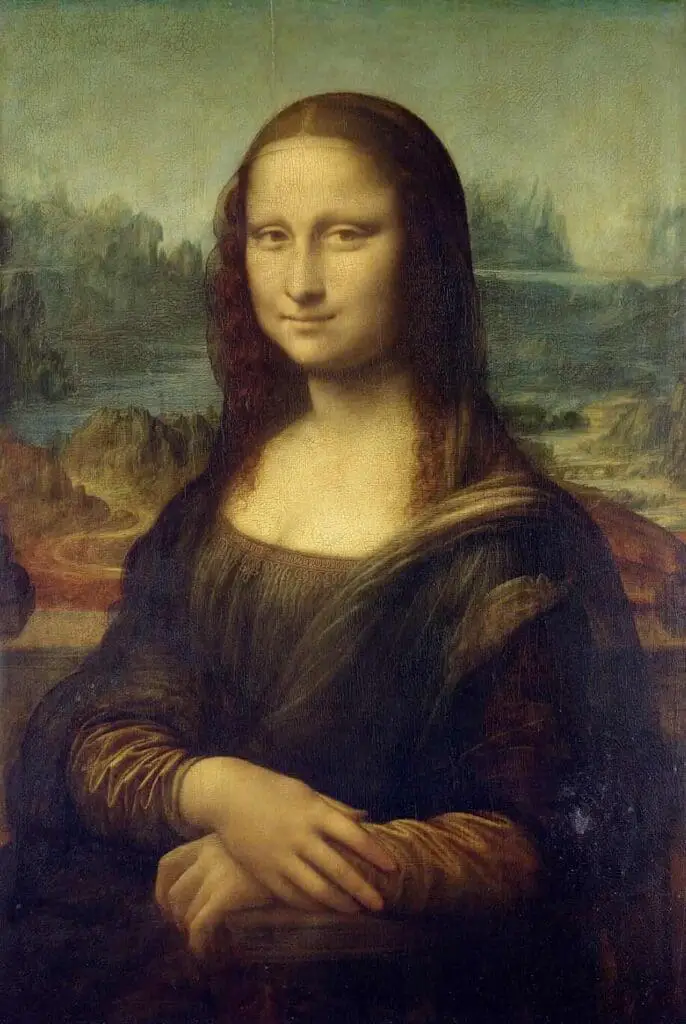
One cannot talk about the High Renaissance without shining a light on the “Mona Lisa,” painted by none other than Leonardo da Vinci. This enigmatic portrait, known for its mysterious smile, showcases Leonardo’s unmatched skill in capturing the subtle nuances of human expression. The “Mona Lisa” is more than just a painting; it’s a study in psychology, an exploration of the human soul, and a testament to Leonardo’s obsession with perfection. The depth achieved through his techniques, like sfumato, adds a lifelike quality to the painting, making it a cornerstone of High Renaissance art.

Michelangelo’s “David,” sculpted with an uncanny attention to detail, is a monumental tribute to human beauty and strength. This masterpiece transcends mere representation; it embodies the Renaissance ideals of perfect human form, echoing the ancient Greek emphasis on harmonious proportions. Michelangelo’s ability to extract such raw emotion and realism from a single block of marble speaks volumes about his innovative approach to sculpture. “David” is not just a statue; it’s a symbol of the High Renaissance’s quest to revive and surpass the glory of the classical past.
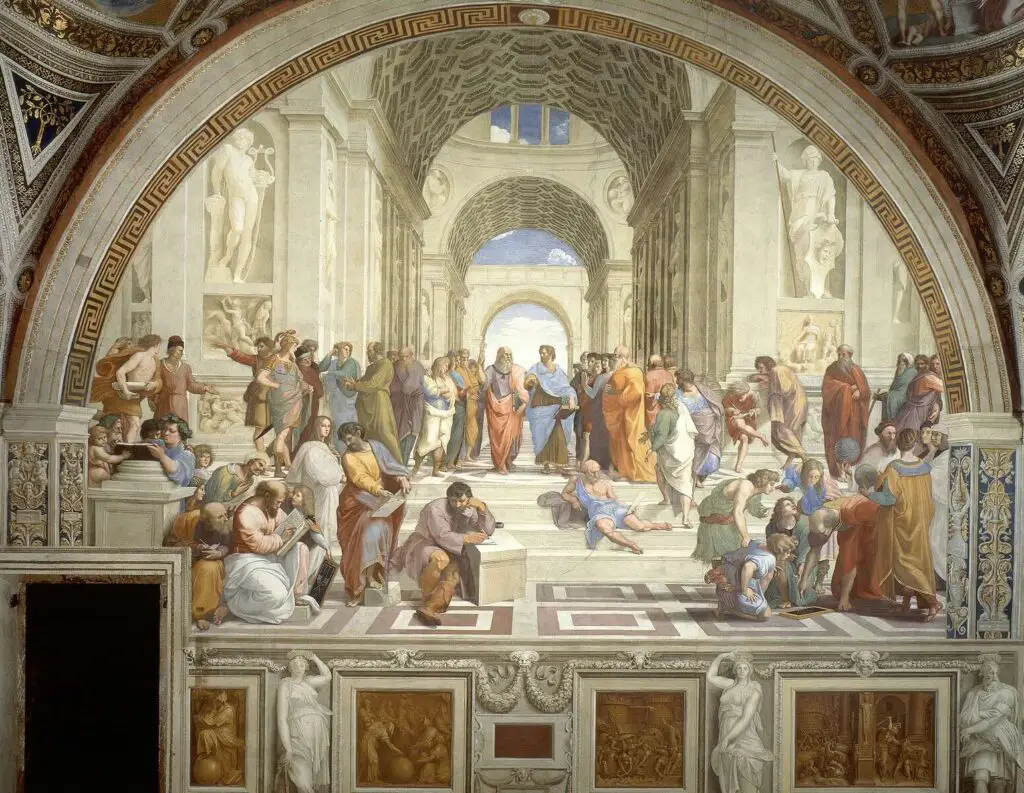
Raphael’s “School of Athens” fresco, adorning the walls of the Vatican, serves as a grand congregation of the greatest minds of antiquity. Raphael pays homage to ancient philosophers and scientists through this masterpiece and showcases the Renaissance’s reverence for learning and intellectual exchange. The precise use of perspective draws the viewer into a world where Plato and Aristotle debate, surrounded by the luminaries of the ancient world. With its dynamic composition and rich symbolism, this fresco epitomizes the High Renaissance’s amalgamation of art, science, and philosophy.
Beyond these iconic figures, the High Renaissance was adorned with other remarkable artists and artworks. Titian’s vibrant use of color and texture in his paintings, such as “Assumption of the Virgin,” introduced a new level of emotional depth and realism to religious themes. His mastery of color theory and innovative brushwork techniques significantly departed from the sensuality and drama defining the Venetian School.
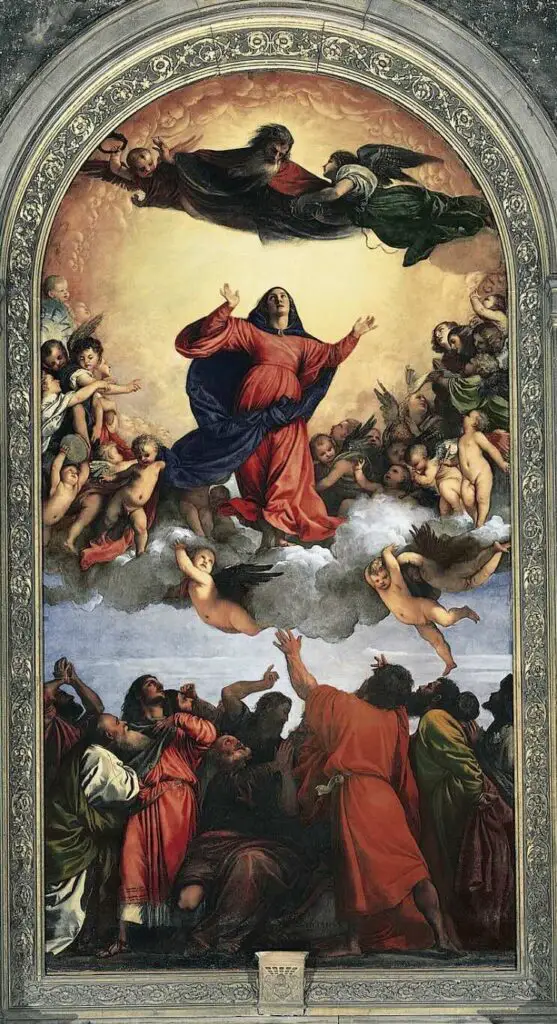
Beyond the canvases and marble, the High Renaissance era was also a time of architectural triumphs. With its grandiose dome, Donato Bramante’s design for St. Peter’s Basilica in Rome became a beacon of Renaissance architecture, symbolizing the amalgamation of spiritual and artistic aspirations. Bramante’s works laid the foundations for what would become some of the most awe-inspiring architectural feats in human history, influencing generations of architects to come.
The impact of these masterpieces and their creators cannot be overstated. They defined the zenith of the High Renaissance and set the stage for the following artistic revolutions. The artworks from this era remain a testament to human creativity’s boundless potential, continuing to inspire and awe. As we reflect on the High Renaissance’s contributions, we find a period that was not just about art but about humanity’s relentless pursuit of knowledge, beauty, and excellence. These masterpieces, timeless in their appeal, remind us of the power of human imagination and creativity to transcend the ages.
Influence and Legacy
Let’s explore how High Renaissance art shaped the future, focusing on aspects that have thrilled art lovers for centuries and laid the foundation for modern artistic pursuits and theory.
Influence of High Renaissance Art on Modern Education
One cannot overlook the profound impact of High Renaissance art on modern education. The era emphasized a multidisciplinary approach that merged art with science, mathematics, and philosophy. This blend pushed the boundaries of traditional education systems of the time and encouraged a holistic understanding of subjects. Today, STEAM (Science, Technology, Engineering, the Arts, and Mathematics) education embodies this very ethos, demonstrating the lasting influence of High Renaissance principles on nurturing creative and analytical minds in harmony.
Revolutionizing Artistic Expression and Techniques
The High Renaissance was a period of innovation that unleashed new avenues for artistic expression. Artists began experimenting with oils, allowing for richer textures and a graver depth of color in paintings. This technique gave rise to a vibrant clarity unseen in earlier works and set the stage for the lush visual narratives found in baroque art. Additionally, the era’s exploration of light, shadow, and emotion through chiaroscuro profoundly influenced the tenebrism technique later employed by Caravaggio and other baroque artists, showcasing a direct lineage of stylistic innovation.
Architectural Marvels That Inspire Today
The High Renaissance was a defining era for architecture, not just in painting and sculpture. Structures like St. Peter’s Basilica showcased the architectural genius of individuals like Bramante and set a precedent for combining functionality with awe-inspiring beauty. This synergy of utility and aesthetics is mirrored in contemporary architecture, where form and function are inseparable. Modern architects often draw inspiration from the balanced proportions and harmonious designs of High Renaissance architecture, continuing the legacy of innovation and beauty.
The Impact on Modern Aesthetics and Culture
The High Renaissance era significantly influenced modern aesthetics and cultural narratives. The movement’s emphasis on humanism and celebrating human achievement, beauty, and emotion resonate within today’s cultural landscapes. The idealized forms and expressive content of High Renaissance art have been found to echo in modern cinema, photography, and digital art, where the exploration of human nature, emotion, and aesthetic excellence remains central. The era’s pioneering spirit continues to inspire artists and creators to push boundaries and explore new dimensions of expression.
Preservation and Continuation of Artistic Heritage
Lastly, the reverence for High Renaissance art has highlighted the importance of preserving cultural and artistic heritage. Museums, galleries, and educational institutions worldwide dedicate substantial resources to conserving these masterpieces, ensuring their longevity. Moreover, the period is an invaluable study subject for art students and enthusiasts, perpetuating the skills, techniques, and philosophies pioneered during this golden age. This ongoing preservation and academic engagement ensure that the innovations and ideals of the High Renaissance continue to influence and shape future generations.
In sum, the High Renaissance was not merely an epoch of unparalleled artistic achievement but a beacon that illuminated the paths of future discovery, innovation, and expression across multiple disciplines. The era’s rich legacy is a testament to the timeless impact of merging art with science, fostering an environment where creativity knows no bounds. Through the continual study and celebration of High Renaissance art, we pay homage to a past that significantly shapes our present and future artistic landscapes.
Exploring the High Renaissance has been like taking a whirlwind tour through one of the most exhilarating periods in art history. We’ve encountered genius artists, groundbreaking techniques, and artworks that have stood the test of time, continuing to dazzle and inspire.
The legacy of the High Renaissance isn’t just preserved in the museums or galleries; it lives on in the way we appreciate beauty, pursue innovation, and understand the power of human creativity. The imprints of Leonardo, Michelangelo, Raphael, and their contemporaries are etched not just on canvas or marble but in the soul of art history, reminding us of a time when art transcended boundaries and set new horizons for those who dared to dream. Even as we move forward, the High Renaissance remains a beacon of artistic excellence, its influence echoing in the halls of modern creativity.
Anita Louise Art is dedicated to art education, great artists, and inspiring others to find and create their art. We love art that uplifts and inspires. #ArtToMakeYouSmile! #ArtToMakeYouHappy!
If you are interested to see any of my art, you can find out more by clicking here. If you are interested in what inspires me and my paintings, you can discover more by clicking here.
We have a free newsletter and would love you to be part of our community; you can subscribe to the newsletter by clicking here. If you have any questions, I would be happy to talk to you. You can reach me, Anita, by clicking here.
Subscribe to our Anita Louise Art YouTube Channel filled with great videos and information by clicking here.
Join us for our podcast “5 Minutes With Art.” Spend just 5 minutes a week with us to discover and learn about great art and artists. You can find out more about our podcast by clicking here.
Related Questions
What Was The Focus Of Renaissance Art?
The focus of Renaissance art was on the classics of Greek and Rome, humanist philosophy, and the study of the human figure. Realism was also an essential part of renaissance art. The great artists of the Renaissance also became great anatomists and studied human beings.
By clicking here, you can learn more by reading What Was The Focus Of Renaissance Art?
What Is The Importance Of Art From The Renaissance Period?
Renaissance art is essential as it was a time of rebirth and discovery. Artists like Leonardo da Vinci, Michelangelo, and Raphael were at the forefront of that change, creation, and discovery. Renaissance art has influenced art and artists for many centuries and continues to influence artists today.
By clicking here, you can learn more by reading What Is The Importance Of Art From The Renaissance Period?
Did Leonardo da Vinci Believe In God?
Leonardo did not tell us what his belief in God was, but there is evidence that is left that suggests that he held fast to many Christian ideals and beliefs. People such as the artist and author Giorgio Vasari, who knew him and wrote about him, spoke of his character and what a great man he was.
By clicking here, you can learn more by reading Did Leonardo da Vinci Believe In God?

